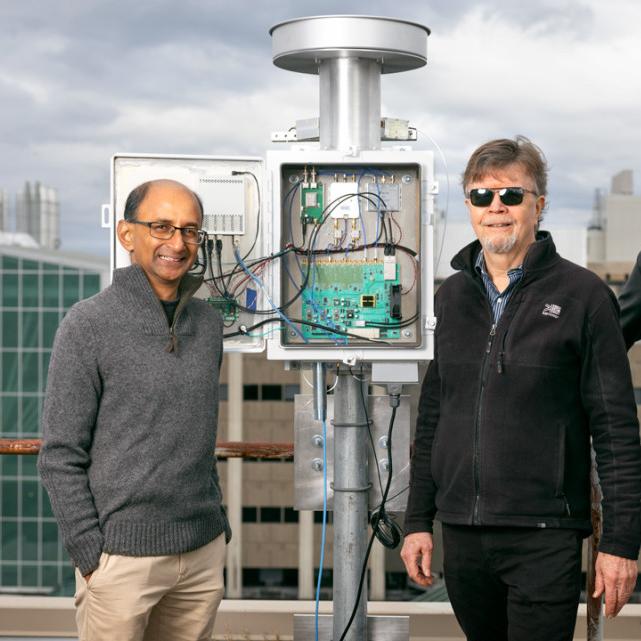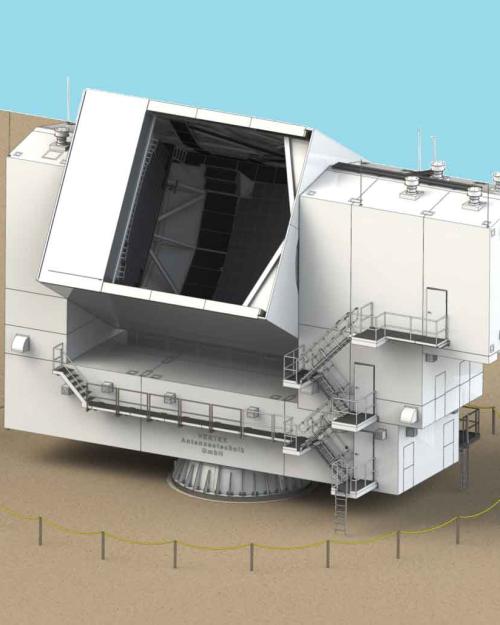More than 80 scientists and engineers (20 online) participated in the fourth annual meeting of the CCAT Consortium on June 20-22 on Cornell’s campus. CCAT Observatory Inc. is a Cornell-led international consortium that is building the Fred Young Submillimeter Telescope (FYST) that is currently being assembled in Germany.
When FYST is completed, it will be installed near the summit of Cerro Chajnantor in Chile’s Atacama Desert and become the second highest telescope in the world. Outfitted with cutting edge instrumentation, FYST will be able to rapidly map the sky at submillimeter to millimeter wavelengths, collecting data that will give scientists insight into “cosmic dawn,” the universe’s earliest days, as well as play a role in the search for gravitational waves and dark matter.
“This was a critical meeting as we are less than two years out from anticipated first light with the facility. The primary goal of the meeting was to prepare ourselves for the first year of telescope operations,” said project director Gordon Stacey, professor of astronomy in the College of Arts & Sciences. “To do so, we need to formulate our ‘Early Science’ plans, which means laying out the science goals, the observing schedule and the publication teams necessary to obtain, process and publish novel science that demonstrates the capabilities of the FYST telescope and the CCAT instruments.”
A second goal, said Stacey, was the creating of data pipelines and map-making software. In response, a new data/map making pipeline working group was established. It has already begun its work, with bi-weekly calls.
The meeting covered a wide range of important issues related to FYST science, from data archiving to survey strategies to sky simulations, with each of the science working groups presenting their plans. It also included updates on the telescope construction, site infrastructure, and the CCAT Prime-Cam (which is Cornell-led) and CHAI (University of Cologne-led) instruments.
“There are many steps in between taking the raw data from the mountain and turning it into science grade data (like 2D maps or 3D data cubes),” said FYST project scientist Nicholas Battaglia, assistant professor of astronomy (A&S). “It was exciting to see that many of the steps/pieces exist in some form within the CCAT collaboration, but there is still a non-trivial amount of work needed to bring these separate steps/pieces together into a coherent pipeline and to test its robustness.”
One of the early science goals discussed, using the spectroscopic camera, EoR-Spec, to create a spectral line map of a galaxy cluster that will look back in time about 12 billion years, is particularly exciting, according to Stacey.
“One theory of galaxy growth is that gas from the cosmic web at mega-parsec scales flows into galaxies, providing fuel for the next generation of star formation and leading to galaxy growth,” he said. “There are also flows out from galaxies driven by active galactic nuclei and supernova events, so key questions about galaxy growth entail investigating the gas content and flows in the circumgalactic medium. One of our early science programs is designed to detect this matter spectroscopically.”
For Battaglia, the outcome of the line intensity mapping science working group’s presentation was most significant. “They proposed an alternate analysis method to detect line emission from the interstellar medium of high redshift galaxies, which is potentially more promising than the method we were initially thinking about using,” he said.
FYST will also enable unique, new science in the local universe. “The telescope’s fast mapping capabilities will make it possible to survey our own Milky Way to an extent that has not been possible before in submillimeter spectral lines,” said Robert Simon of Cologne University, FYST deputy project scientist and lead of the Galactic Ecology project to be conducted with the CHAI instrument. “Now is the time to prepare for the initial early science observations and this consortium meeting at Cornell provided the framework to make important progress.”
Many of the participants expressed their pleasure in meeting again after the isolation of the pandemic. “There's something about in-person meetings that is simply lost in virtual meetings,” said Battaglia.
Stacey agreed. “The face- to-face environment invites more lively and productive conversations and gave us the chance to renew old collaborations and friendships. Meeting together in person enables a group conversation that uncovered some important issues that are not yet addressed. For instance, after the meeting’s formal conclusion we had extensive meetings amongst the group of software experts to organize the team that will deliver the pipeline from detector signals to calibrated maps. This vital post-meeting gathering truly jump-started these critical team efforts.”
The in-person nature of the meeting also enabled participants to personally thank Terry Herter, professor of astronomy (A&S), for serving as project director from July 1, 2017 to June 30, 2023, taking over from the late Riccardo Giovanelli, professor emeritus of astronomy (A&S), who initially led the project. Martha Haynes, chair of the CCAT Board of Directors and Distinguished Professor of Arts & Sciences in Astronomy (A&S), noted that Herter first went with her and Giovanelli to look at sites in the Chajnantor region in 1997.
“Since the early days of the project, Terry has contributed his scientific and technical expertise in so many critical ways,” said Haynes. “His leadership as project director has positioned us for a very bright and scientifically transformational future as this meeting has so clearly demonstrated.”
While a few technical challenges have arisen regarding the assembly of the FYST’s most complex structures, first light remains as projected for 2025. “The entire FYST design is a first of its kind, so these types of fabrication and production issues are not unexpected,” said Jim Blair, FYST project manager (A&S). “The great news is we continue to tackle every technical and production challenge that arises.”








